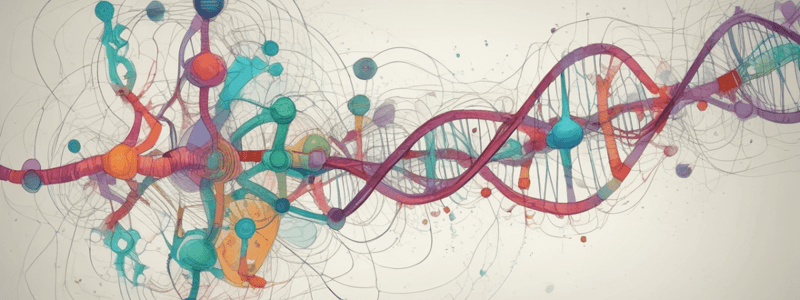Podcast
Questions and Answers
What is the primary function of the sigma factor in the initiation complex?
What is the primary function of the sigma factor in the initiation complex?
- To recognize and bind to specific promoter sequences (correct)
- To bind to the RNA polymerase and position it for transcription initiation
- To stimulate transcriptional elongation
- To transcribe DNA into RNA
What is the role of the catalytic core enzyme in RNA polymerase?
What is the role of the catalytic core enzyme in RNA polymerase?
- To transcribe DNA into RNA (correct)
- To recognize and bind to specific promoter sequences
- To modulate gene expression
- To stimulate transcriptional elongation
Which of the following factors can influence transcriptional elongation rates?
Which of the following factors can influence transcriptional elongation rates?
- RNA polymerase processivity and presence of transcriptional elongation factors (correct)
- Sequence-specific features of the DNA template only
- Presence of transcriptional initiation factors
- Chromatin structure and accessibility only
What is the primary function of transcriptional pausing?
What is the primary function of transcriptional pausing?
What is the effect of NusA on transcriptional elongation?
What is the effect of NusA on transcriptional elongation?
What is the function of Mfd in transcriptional elongation?
What is the function of Mfd in transcriptional elongation?
Where can regulation of transcription probably occur?
Where can regulation of transcription probably occur?
What is the role of the protein Tat in transcriptional elongation?
What is the role of the protein Tat in transcriptional elongation?
What is the purpose of phosphorylation at Ser2 in RNA polymerase?
What is the purpose of phosphorylation at Ser2 in RNA polymerase?
What happens when RNA polymerase encounters the first nucleosome?
What happens when RNA polymerase encounters the first nucleosome?
What is the outcome when RNA polymerase is poised at the nucleosome?
What is the outcome when RNA polymerase is poised at the nucleosome?
What is the general trend in regulation of transcriptional elongation?
What is the general trend in regulation of transcriptional elongation?
What is the duration of pausing in transcriptional elongation?
What is the duration of pausing in transcriptional elongation?
What is the significance of the TAR sequence in transcriptional elongation?
What is the significance of the TAR sequence in transcriptional elongation?
What is the outcome when RNA polymerase is not phosphorylated at Ser2?
What is the outcome when RNA polymerase is not phosphorylated at Ser2?
What is the purpose of the P-TEF complex in transcriptional elongation?
What is the purpose of the P-TEF complex in transcriptional elongation?
What is the result of transcriptional pausing at the nucleosome?
What is the result of transcriptional pausing at the nucleosome?
What is the role of P-TEFb in transcription elongation?
What is the role of P-TEFb in transcription elongation?
What is the effect of DSIF on transcription elongation?
What is the effect of DSIF on transcription elongation?
How does P-TEFb interact with the RNA polymerase?
How does P-TEFb interact with the RNA polymerase?
What is the role of CycT1 in transcription elongation?
What is the role of CycT1 in transcription elongation?
What is the effect of HEXIM on P-TEFb activity?
What is the effect of HEXIM on P-TEFb activity?
What is the characteristic of genes with paused polymerases at the +1 nucleosome?
What is the characteristic of genes with paused polymerases at the +1 nucleosome?
What is the role of repressors in transcription elongation?
What is the role of repressors in transcription elongation?
What is the characteristic of promoters with paused polymerases?
What is the characteristic of promoters with paused polymerases?
What is the role of activators in transcription elongation?
What is the role of activators in transcription elongation?
What is the characteristic of TATA-like promoters?
What is the characteristic of TATA-like promoters?
Flashcards are hidden until you start studying
Study Notes
Regulación de la transcripción
Initiation Complex
- Formation of a complex between RNA polymerase, sigma factor, and DNA promoter region
- Sigma factor recognizes and binds to specific promoter sequences
- RNA polymerase binds to the promoter region, positioning it for transcription initiation
- Initiation complex formation is a key regulatory step in transcription
RNA Polymerase
- Responsible for transcribing DNA into RNA
- Composed of multiple subunits, including the catalytic core enzyme and additional regulatory subunits
- RNA polymerase moves along the DNA template, adding nucleotides to the growing RNA chain
- Can be targeted by transcriptional regulators to modulate gene expression
Transcriptional Elongation Rates
- Measure of how quickly RNA polymerase transcribes the DNA template
- Influenced by factors such as:
- RNA polymerase processivity
- Presence of transcriptional elongation factors
- Chromatin structure and accessibility
- Sequence-specific features of the DNA template
- Elongation rates can impact gene expression levels and transcriptional regulation
Transcriptional Pausing
- Temporary halting of RNA polymerase during transcription
- Can occur at specific sequences or structures, such as:
- Pause sites
- Hairpin structures
- Repetitive sequences
- Transcriptional pausing can be a regulatory mechanism, allowing for:
- Temporal regulation of gene expression
- Spatial regulation of gene expression
- Co-transcriptional processing of the RNA transcript
Elongation Factors
- Proteins that interact with RNA polymerase to modulate transcriptional elongation
- Can stimulate or inhibit transcriptional elongation, depending on the factor
- Examples of elongation factors include:
- NusA (stimulates elongation)
- NusG (stimulates elongation)
- GreA and GreB (stimulate elongation and cleavage of backtracked RNA)
- Mfd (stimulates transcriptional proofreading and repair)
Studying That Suits You
Use AI to generate personalized quizzes and flashcards to suit your learning preferences.



